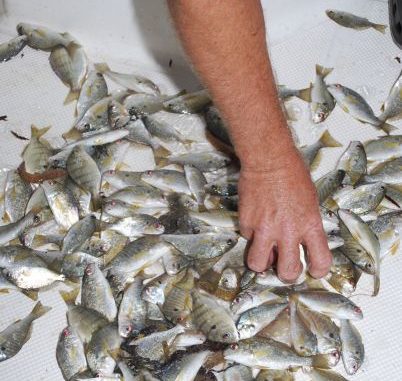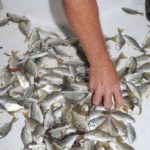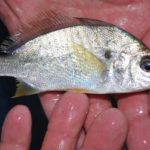
Spot are easy to overlook, even though they are a member of the drum family — the same family that gives us speckled trout and redfish.
The most remarkable thing about this unremarkable fish is that they likely have the shortest name of any fish that swims in the Gulf.
They aren’t called Gulf spot or Atlantic spot or southern spot or silver spot or striped spot — just “spot.”
Of course, we in Louisiana who have a penchant for naming everything to suit us, call them “sand diggers,” a pretty good description that we will come back to later.
Scientifically, the fish was named Leiostomus xanthurus by the French scientist Bernard-Germain-Étienne de La Ville-sur-Illon, compte de La Cépède (How’s that for a name?).
Even though he named the fish, it is likely that he didn’t see one — at least a live one.
The name xanthurus means “yellow tail” in Greek. While none of its fins are yellow, they do have yellowish highlights, with the tail fin being the least yellow of all.
Leiostomus, on the other hand, is very descriptive, interpreted from Greek as “smooth mouth.”
The name likely refers to the fact that the fish has no barbels (aka whiskers) under its chin, unlike so many others in its family — black drum, kingfish (aka channel mullet) and its closest look-alike relative, the Atlantic croaker.
Found from Maine south along the Atlantic and Gulf coasts all the way into northern Mexico, spots are truly one of the most-common fish found in shallow coastal and bay waters.
Generally speaking, wherever croakers are found, spots of about the same size will be found.
Not only are spots and croakers found together in the same habitats, they closely resemble each other — so much so that some fishermen can’t tell the two species apart.
A little scrutiny reveals that spots are much deeper bodied, always have a single black spot on each “shoulder” and have a noticeably forked tail.
Croakers have a convex tail edge, with the longest point being in the middle.
In the last 20 years, croakers have become very popular live bait for speckled trout and mangrove snappers. Anglers who pull a trawl to catch their own bait often catch as many or more spot as croakers.
Some fishermen despise them, claiming speckled trout never eat them. Some report no difference between the two. A few actively use spots for bait.
When I was doing the field work for the book “Trout Masters: How Louisiana’s Best Anglers Catch the Lunkers,” I found the great troutmaster Bootsie Toups to be one of the latter.
Bootsie, who has probably won more fishing tournaments and rodeos than any Louisianan, specialized in fishing a treble hook-bearing Texas rig with live bait. It was his common practice to put a croaker on one hook of his treble and a spot on another.
His explanation was “one for sight and one for sound.”
Spots, with their wide, shiny bodies, were for sight.
While spots do make a croaking sound (like all the members of the drum family) during spawning courtship, they are almost silent when compared to croakers, which croak loudly and, it seems, almost non-stop.
As for spots being a target species for anglers, it just doesn’t happen in Louisiana like it does on the Atlantic coast. That has a lot to do with size.
For some reason, a 6-inch spot in Louisiana is a real stud. On the Atlantic coast they commonly grow to 12 inches long and occasionally longer.
The IGFA world record is a 1-pound, 7-ounce fish taken in Virginia.
Most references list their flesh as having good to excellent taste.
Not only recreational fishermen targeted them. Until the gill net ban destroyed the fishery in Florida in 1995, more than a million pounds (sometimes more than 4 million pounds) were landed on the state’s Atlantic coast annually.
Some idea of their popularity on the Atlantic Coast is that an annual Spot Festival is held the last weekend of September in Hampstead, N.C.
Spot can live to 5 years old, with sexual maturity usually occurring at 2 years of age. Spawning takes place offshore. Mature fish have been found at depths ranging from 30 to 300 feet.
Spawning in the Gulf begins in December, and peaks in January and February. They can spawn repeatedly over a several-week period. The eggs are buoyant and float at the mercy of water movement. Like with other members of the drum family, spawning takes place a night.
After hatching, larvae feed actively on microscopic zooplankton while water movement carries them into inshore bays and marshes. They are typically a third of an inch to 1 inch long and 40 to 47 days old when they hit the estuaries.
In this food-rich habitat they grow quickly, reaching an average of 5.9 inches long by their first birthday.
While marsh estuaries provide a lot of food, environmental conditions are unpredictable. Spot are tough fish and can tolerate temperatures ranging from 35 degrees to 95 degrees and salinities ranging from pure freshwater to 37 parts per thousand salt. For comparison, full strength seawater is 32 ppt.
By late fall, they move from inshore nursery waters to offshore waters, probably in response to declining water temperatures.
Once spots have grown past the larval stage they become strict bottom feeders, spending most of their time rooting for lunch nose-down in the bottom. This is probably how they picked up their Louisiana nickname of sand digger.
The most-common food items found in their stomachs are segmented worms, although spots will eat almost any living or formerly living thing they find in the mud or sand.
Substantial amounts of sand are often found in their stomachs, probably swallowed inadvertently while the sand digger was digging.




